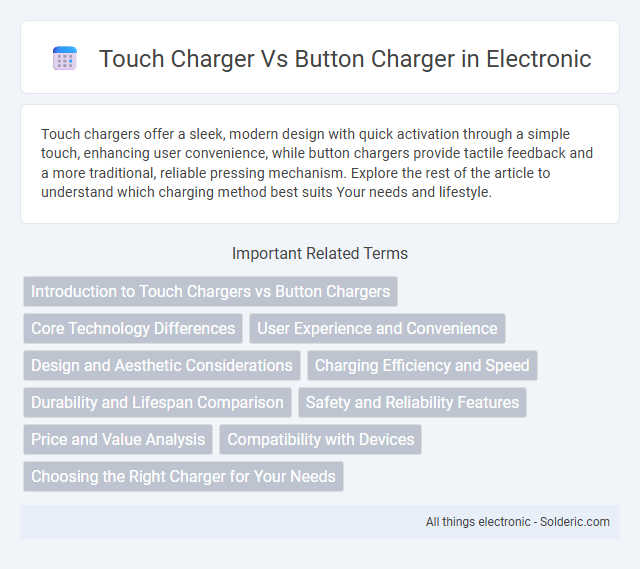Touch chargers offer a sleek, modern design with quick activation through a simple touch, enhancing user convenience, while button chargers provide tactile feedback and a more traditional, reliable pressing mechanism. Explore the rest of the article to understand which charging method best suits Your needs and lifestyle.
Comparison Table
| Feature | Touch Charger | Button Charger |
|---|---|---|
| Activation Method | Capacitive touch sensor | Physical press button |
| Durability | Less wear, no moving parts | Prone to mechanical wear |
| Response Time | Instant activation | Slight delay due to mechanical action |
| Ease of Use | Requires light touch, no force | Requires pressing force |
| Design | Sleek, seamless surface | Raised or recessed button |
| Water Resistance | Higher, due to no gaps | Lower, possible water ingress |
| Power Consumption | Minimal standby power | No power used when idle |
| Cost | Generally higher | Generally lower |
Introduction to Touch Chargers vs Button Chargers
Touch chargers offer a sleek, modern solution with a responsive sensor that activates charging upon skin contact, enhancing user convenience and minimizing wear from mechanical parts. Button chargers rely on physical presses to start charging, providing a tactile, familiar interaction but potentially suffering from mechanical fatigue over time. You can choose based on preference for durability or advanced touch sensitivity in your charging devices.
Core Technology Differences
Touch chargers utilize capacitive sensing technology, allowing detection of your finger through changes in electrical charge, enabling seamless and contactless activation. Button chargers rely on mechanical switches that physically complete the circuit when pressed, resulting in tactile feedback and a more traditional user interface. The core technology difference lies in capacitive touch sensors versus mechanical actuation mechanisms, impacting durability, responsiveness, and user experience.
User Experience and Convenience
Touch chargers offer a seamless user experience by allowing you to activate charging with a simple tap, eliminating the need for physical pressure and reducing wear and tear. Button chargers provide tactile feedback, giving users a clear indication of activation, which some find reassuring for precise control. Your convenience depends on preference: touch chargers enhance sleek interaction while button chargers emphasize reliable, deliberate engagement.
Design and Aesthetic Considerations
Touch chargers feature sleek, smooth surfaces with minimalist interfaces that blend seamlessly into modern environments, enhancing aesthetic appeal. Button chargers incorporate tactile, physical buttons that provide a more traditional look and feel, often appealing to those who prefer clear, responsive controls. The choice between touch and button chargers depends largely on user preference for futuristic design versus classic functionality.
Charging Efficiency and Speed
Touch chargers typically offer faster charging speeds due to advanced sensor technology that optimizes power delivery based on device compatibility, reducing energy loss. Button chargers rely on manual activation, which may cause inconsistent power flow and slower charging efficiency. Devices equipped with touch chargers benefit from more stable voltage regulation, leading to quicker battery replenishment and enhanced overall charging performance.
Durability and Lifespan Comparison
Touch chargers typically have a longer lifespan due to fewer moving parts, reducing wear and tear compared to button chargers, which rely on mechanical switches prone to degradation over time. The sealed design of touch chargers often provides better protection against dust and moisture, enhancing durability. Your choice for long-term use should consider that touch chargers generally offer increased reliability and extended service life in demanding environments.
Safety and Reliability Features
Touch chargers use capacitive technology, reducing physical wear and minimizing short-circuit risks due to sealed surfaces that prevent dust and moisture intrusion. Button chargers rely on mechanical switches prone to contact degradation and accidental sparks, which can compromise safety over time. Advanced touch chargers incorporate overcurrent and temperature protection, enhancing reliability beyond traditional button-based designs.
Price and Value Analysis
Touch chargers often come with a higher upfront price due to advanced sensor technology but offer enhanced durability and ease of use, which can lead to better long-term value. Button chargers typically feature a lower initial cost but may require more frequent maintenance or replacement due to mechanical wear and tear. Evaluating total cost of ownership, touch chargers provide greater value for environments prioritizing convenience and reliability, while button chargers suit budget-conscious users with less demanding usage.
Compatibility with Devices
Touch chargers offer broad compatibility with a wide range of modern smartphones and tablets equipped with capacitive touchscreens. Button chargers, often designed for specific models or older devices with physical buttons, may not support newer touch-sensitive technology. Selecting a charger depends on ensuring device compatibility to optimize charging efficiency and user experience.
Choosing the Right Charger for Your Needs
Selecting between a touch charger and a button charger depends on user preference and device compatibility, with touch chargers offering seamless, sensor-based activation and button chargers providing tactile feedback through physical presses. Touch chargers are ideal for sleek, modern devices emphasizing convenience and minimal wear, while button chargers excel in durability and precise control for rugged applications. Evaluating factors such as ease of use, durability, and the specific charging environment ensures optimal performance and user satisfaction.
Touch charger vs button charger Infographic

 solderic.com
solderic.com